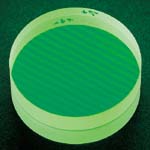|
Surface
Flatness
is the deviation for a plano surface such as a window or mirror.
When a test plate (typically an optical flat, as shown below)
is held in contact with the work piece (the part under inspection),
a contour map is visible as light and dark bands. These dark
bands are called Newton's rings or fringes. Due to the air
gap between the surfaces, each ring corresponds to the vertical
distance between the test plate and the surface under inspection.
Since the test plate in this case is a clear, flat reference,
the air gap is very small so the surface flatness is defined
in terms of wavelength (very small unit of measure); i.e.
1/4 wave or l/4.
The spacing between rings is equal to one-half the wavelength
of the illumination source; i.e. 1/4 wave = 1/2 ring. A monochromatic
green light at the 546.1 nm mercury line or helium-neon red
laser line at 632.8 nm is used for illumination. Typically,
only values less than 1/4 wave are considered to be precision
and values less than l/10
to be high precision.
|
 |
